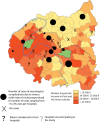Marked increase in severe neurological disorders after nitrous oxide abuse: a retrospective study in the Greater Paris area
- PMID: 38478030
- PMCID: PMC11136741
- DOI: 10.1007/s00415-024-12264-w
Marked increase in severe neurological disorders after nitrous oxide abuse: a retrospective study in the Greater Paris area
Abstract
Background: Recreational nitrous oxide (N2O) use has become more widespread worldwide, leading to an increase in myelopathies and peripheral neuropathies. The aim of this study was to describe clinical and socioeconomical characteristics of severe N2O-induced (NI) neurological disorders (NI-NDs), to determine its incidence in the Greater Paris area and to compare it with that of similar inflammatory neurological disorders.
Methods: We performed a retrospective multicentric cohort study of all adult patients with severe NI-NDs in the neurology and general internal medicine departments of the Greater Paris area from 2018 to 2021. The incidence was compared with that of non-NI-myelitis and Guillain-Barré syndrome (GBS) using a sample of 91,000 hospitalized patients sourced from health insurance data.
Results: Among 181 patients, 25% had myelopathy, 37% had peripheral neuropathy and 38% had mixed disease. Most were aged between 20 and 25 years, lived in socially disadvantaged urban areas, and exhibited high rates of unemployment (37%). The incidence of NI-NDs increased during 2020 and reached a peak mid-2021. The 2021 incidence in 20-25-year-olds was 6.15 [4.72; 8.24] per 100,000 persons for NI-myelopathy and 7.48 [5.59; 9.37] for NI-peripheral neuropathy. This was significantly higher than for non-NI-myelitis (0.35 [0.02; 2.00]) and GBS (2.47 [0.64; 4.30]). The incidence of NI-NDs was two to three times higher in the most socially disadvantaged areas.
Conclusion: The recent increase in recreational N2O use has led to a rise in the incidence of severe NI-NDs, particularly in young adults with low socioeconomic status for whom NI-NDs strongly outweigh similar neurological disorders.
Keywords: Epidemiology; Myelopathy; Nitrous oxyde abuse; Peripheral neuropathy.
© 2024. The Author(s).
Conflict of interest statement
The authors declare that they have no conflict of interest.
Figures



Similar articles
-
The sharp rise of neurological disorders associated with recreational nitrous oxide use in China: a single-center experience and a brief review of Chinese literature.J Neurol. 2020 Feb;267(2):422-429. doi: 10.1007/s00415-019-09600-w. Epub 2019 Oct 26. J Neurol. 2020. PMID: 31655888 Review.
-
Possible impact of the COVID-19 pandemic on the recreational use of nitrous oxide in the Paris area, France.Rev Med Interne. 2022 Jul;43(7):402-405. doi: 10.1016/j.revmed.2022.06.004. Epub 2022 Jun 15. Rev Med Interne. 2022. PMID: 35773094 Free PMC article.
-
Skin hyperpigmentation: a rare presenting symptom of nitrous oxide abuse.Clin Toxicol (Phila). 2020 Jun;58(6):476-481. doi: 10.1080/15563650.2019.1665181. Epub 2019 Sep 16. Clin Toxicol (Phila). 2020. PMID: 31522576
-
Nitrous Oxide-Induced Neuropathy among Recreational Users in Vietnam.Int J Environ Res Public Health. 2021 Jun 9;18(12):6230. doi: 10.3390/ijerph18126230. Int J Environ Res Public Health. 2021. PMID: 34207586 Free PMC article.
-
Imaging appearance of myelopathy secondary to nitrous oxide abuse: a case report and review of the literature.Int J Neurosci. 2019 Mar;129(3):225-229. doi: 10.1080/00207454.2018.1526801. Epub 2018 Dec 4. Int J Neurosci. 2019. PMID: 30234413 Review.
Cited by
-
Recreational nitrous oxide use in France in 2022: Results from a nationwide representative sample of adults.Drug Alcohol Rev. 2025 May;44(4):1182-1193. doi: 10.1111/dar.14039. Epub 2025 Mar 16. Drug Alcohol Rev. 2025. PMID: 40090769 Free PMC article.
-
[Life style drug laughing gas (nitrous oxide, N2O) and the dependency criteria according to ICD-10].Nervenarzt. 2025 May;96(3):284-289. doi: 10.1007/s00115-024-01736-z. Epub 2024 Sep 23. Nervenarzt. 2025. PMID: 39311917 Free PMC article. Review. German.
-
Antidepressant Effects of Nitrous Oxide in Major Depressive Disorder: A Phase 2b Randomized Clinical Trial.Biol Psychiatry Glob Open Sci. 2025 Apr 15;5(4):100504. doi: 10.1016/j.bpsgos.2025.100504. eCollection 2025 Jul. Biol Psychiatry Glob Open Sci. 2025. PMID: 40503328 Free PMC article.
-
Neurotoxicity mechanisms and clinical implications of six common recreational drugs.Front Pharmacol. 2025 Feb 17;16:1526270. doi: 10.3389/fphar.2025.1526270. eCollection 2025. Front Pharmacol. 2025. PMID: 40034818 Free PMC article. Review.
-
Rare but relevant: Nitrous oxide and peripheral neurotoxicity, what do we know?Addiction. 2025 May;120(5):1046-1050. doi: 10.1111/add.16753. Epub 2024 Dec 23. Addiction. 2025. PMID: 39711181 Free PMC article. Review.
References
Publication types
MeSH terms
Substances
LinkOut - more resources
Full Text Sources
Medical

